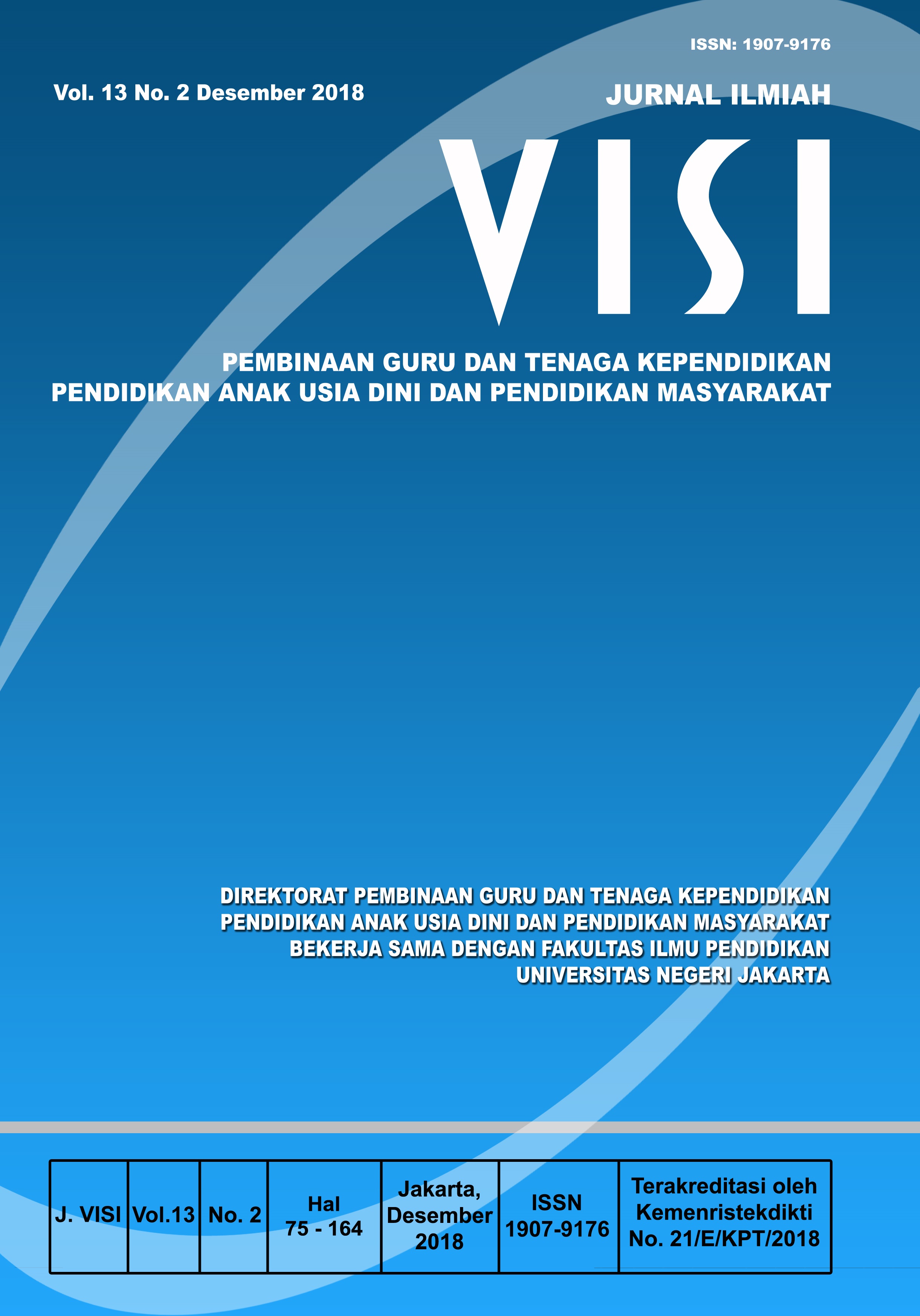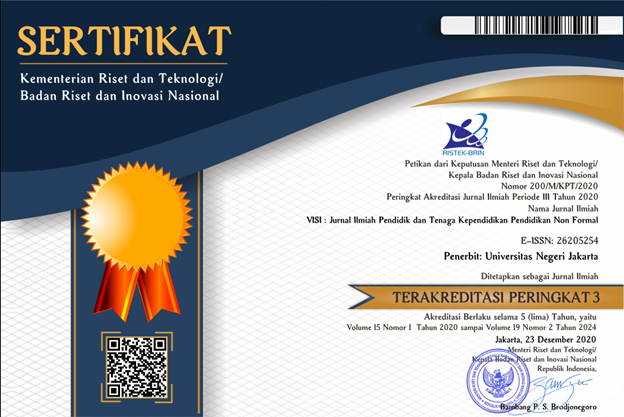IMPLEMENTASI PEMBELAJARAN ORIGAMASAINS UNTUK MENUMBUHKAN KECINTAAN TERHADAP MATEMATIKA DAN SAINS SEJAK DINI
DOI:
https://doi.org/10.21009/JIV.1302.3Keywords:
origami, mathematics, scienceAbstract
This study aims to provide an overview of how the learning using origamasains can emerge fondness to mathematics and science subjects from the early age. The result of the study was expected to become the input for the upcoming learning and the reference for developing the learning at the basic level especially for the mathematics and science subjects. In order to get the accurate research result, the qualitative research method was employed. The data were analyzed using the data collection, data reduction, data presentation, and data validity check procedures. The research was conducted in May - September 2018 at Jageran Yogyakarta early childhood school. The primary data being analyzed were the impression of the students to the given learning and the results of the interviews to the students. The finding showed that the students could learn better using the origamasains learning. In this first activity,
80% of the students showed fondness to the given learning activity, while 20% of the students expressed normal impressions and 0% of the students showed dislike. In this second activity 100% of the students showed fondness to the given learning activity. Meanwhile in the third activity, 75% of the students showed fondness to the given learning activity, 20% of the students expressed normal impressions and 0% of the students showed dislike. In that third activity, the classroom’s good atmosphere was destructed by the crying from some students.
References
Cossentino, J. (2005). Ritualizing expertise: A non-Montessorian view of the Montessori method. American Journal of Education, 111(2), 211-244. doi: http://dx.doi.org/10.1086/426838
Depdiknas. (2006). Peraturan Menteri Pendidikan Nasional No. 22 tahun 2006 tentang standar isi mata pelajaran matematika.
Elytasari, S. (2017). Esensi metode Montessori dalam pembelajaran anak usia dini. Bunayya: Jurnal Pendidikan Anak, 3(1), 59-73. http://jurnal.ar-raniry.ac.id/index.php/bunayya/article/view/2045
Fajarwati, I. (2014). Konsep Montessori tentang pendidikan anak usia dini dalam perspektif pendidikan Islam. Jurnal Pendidikan Agama Islam, 11(1), 37-52. doi: http://dx.doi.org/10.14421/jpai.2014.111-03
Hijriati, H. (2017). Tahapan perkembangan kognitif pada masa early childhood. Bunayya: Jurnal Pendidikan Anak, 1(2), 33-49. https://jurnal.ar-raniry.ac.id/index.php/bunayya/issue/view/289.
Kartono, K. (2007). Psikologi anak (Psikologi perkembangan). Bandung: Mandar Maju.
Lang, R. & Iverson, P. W. (2016). Origami 5: Fifth international meeting of origami science, mathematics, and education. Florida, Amerika: CRC Press.
Lillard, A., & Else-Quest, N. (2006). The early years: Evaluating Montessori education. Science, 313(5795), 1893-1894. doi: https://doi.org/10.1126/science.1132362
Mariana, I. M. A. (2009). Hakikat IPA dan pendidikan IPA. Jakarta: PPPPTK Untuk Program BERMUTU.
Mayer, E. R. (2003). Handbook of psychology, vol. 7 educational psychology 2003. Hoboken: John Wiley & Sons, Inc.
Moleong, L. J. (2005). Metodologi penelitian kualitatif. Bandung: PT Remaja Rosdakarya.
Sanjaya, W. (2009). Strategi pembelajaran berorientasi standar proses pendidikan. Jakarta: PT Kencana.
Sugiyono. (2011). Metode penelitian kuantitatif, kualitatif, dan r & d. Bandung: Alfabeta.
Suherman, E. (2003). Strategi pembelajaran matematika kontemporer. Bandung: JICA Universitas Pendidikan Indonesia.
Susanti, L. (2013). Pembelajaran berbasis origami untuk meningkatkan visualisasi spasial dan kemampuan geometri siswa SMP. MATHEdunesa, 2(2). http://jurnalmahasiswa.unesa.ac.id/index.php/mathedunesa/article/
view/2697
Westwood, P. (2004). Learning and learning difficulties: A handbook for teacher. Camberwell: Acer Press.
Yusuf, S. (2014). Psikologi perkembangan anak dan remaja. Bandung: PT Remaja Rosdakarya.
Downloads
Published
How to Cite
Issue
Section
License
Authors who publish with this Journal agree to the following terms:
- Author retain copyright and grant the journal right of first publication with the work simultaneously licensed under a creative commons attribution licensethat allow others to share the work within an acknowledgement of the work’s authorship and initial publication of this journal.
- Authors are able to enter into separate, additional contractual arrangementfor the non-exclusive distribution of the journal’s published version of the work (e.g. acknowledgement of its initial publication in this journal).
- Authors are permitted and encouraged to post their work online(e.g. in institutional repositories or on their websites) prior to and during the submission process, as it can lead to productive exchanges, as well as earlier and greater citation of published works.
- Users/public use of this website will be licensed to CC BY-NC-SA Creative Commons Attribution-NonCommercial-ShareAlike 4.0 International License









